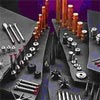Body
 As industry standards increase, so too does the demand for flexibility in specialized gaging procedures. Because there’s no room for error, choosing the right contact point or styli is paramount in conforming to the organization’s high quality standards. Accuracy can be jeopardized by any number of variables, but the contact point shouldn’t be one of them.Styli are manufactured in a number of different designs, shaft materials and tips. Each contact styli is designed for special applications. As the initial contact component of the measuring process, sphericity and rigidity are critical when choosing styli.
As industry standards increase, so too does the demand for flexibility in specialized gaging procedures. Because there’s no room for error, choosing the right contact point or styli is paramount in conforming to the organization’s high quality standards. Accuracy can be jeopardized by any number of variables, but the contact point shouldn’t be one of them.Styli are manufactured in a number of different designs, shaft materials and tips. Each contact styli is designed for special applications. As the initial contact component of the measuring process, sphericity and rigidity are critical when choosing styli. When choosing replacement styli, a few important qualities must be remembered:
- Keep the styli as short as possible to prevent bending or deflecting.
- Use as large a ball or tip as possible.
- Minimize the use of joints or extensions. Custom-made styli are better choices.
The point of contact is the most critical aspect of accurate gaging. Therefore, careful consideration must be given to the probe tip and the ball material:
…
Want to continue?
Log in or create a FREE account.
By logging in you agree to receive communication from Quality Digest.
Privacy Policy.
Add new comment